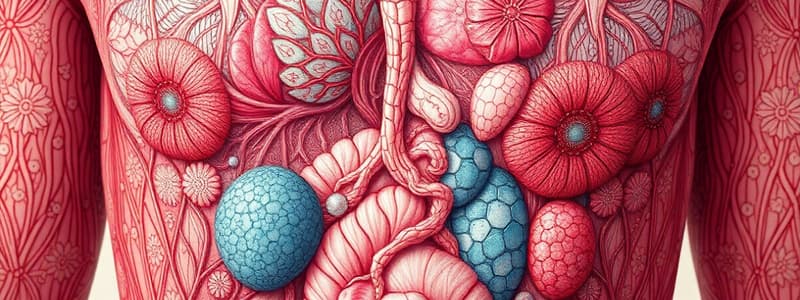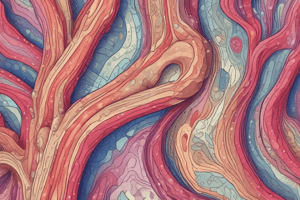Podcast
Questions and Answers
What happens to protein fiber secretion as we age?
What happens to protein fiber secretion as we age?
- It becomes more efficient.
- It decreases. (correct)
- It remains unchanged.
- It increases significantly.
What is the primary role of adipocytes in connective tissue?
What is the primary role of adipocytes in connective tissue?
- Storage of lipids. (correct)
- Blood production.
- Secretion of histamine.
- Support of bone structure.
Which of the following describes the transformation of blast cells?
Which of the following describes the transformation of blast cells?
- Blast cells develop into mast cells after secretion.
- Blast cells remain active throughout their lifespan.
- Blast cells and cyte cells serve identical functions.
- Blast cells change into cyte cells once the matrix is generated. (correct)
Which connective tissue is primarily involved in supporting body weight and stress?
Which connective tissue is primarily involved in supporting body weight and stress?
What distinguishes bone from cartilage in terms of matrix composition?
What distinguishes bone from cartilage in terms of matrix composition?
What substance is released by mast cells that contributes to inflammation?
What substance is released by mast cells that contributes to inflammation?
Which characteristic is true regarding loose connective tissue?
Which characteristic is true regarding loose connective tissue?
What role do osteoblasts play in bone tissue?
What role do osteoblasts play in bone tissue?
What primarily distinguishes dense regular connective tissue from dense regular elastic tissue?
What primarily distinguishes dense regular connective tissue from dense regular elastic tissue?
What is the major cell type found in dense regular connective tissue?
What is the major cell type found in dense regular connective tissue?
Which of the following correctly describes the function of tendons?
Which of the following correctly describes the function of tendons?
Where are dense regular connective tissues primarily located in the body?
Where are dense regular connective tissues primarily located in the body?
Which statement is true regarding the arrangement of fibers in dense regular connective tissue?
Which statement is true regarding the arrangement of fibers in dense regular connective tissue?
What is a key characteristic of ligaments as compared to tendons?
What is a key characteristic of ligaments as compared to tendons?
What type of stress can dense regular connective tissue withstand effectively?
What type of stress can dense regular connective tissue withstand effectively?
What role does fascia play in relation to muscles?
What role does fascia play in relation to muscles?
What is the primary function of the stratum basale?
What is the primary function of the stratum basale?
Which cells are primarily found in the stratum spinosum layer?
Which cells are primarily found in the stratum spinosum layer?
What condition can cause the stratum spinosum to appear prickly?
What condition can cause the stratum spinosum to appear prickly?
What is contained within the dermal papillae?
What is contained within the dermal papillae?
Which layer of the epidermis is directly associated with the dermis?
Which layer of the epidermis is directly associated with the dermis?
Which factor stimulates mitosis in the stratum basale?
Which factor stimulates mitosis in the stratum basale?
What are friction ridges made from?
What are friction ridges made from?
What type of tissue forms the papillary layer of the dermis?
What type of tissue forms the papillary layer of the dermis?
What type of epithelium is characterized by a single layer of cube-like cells?
What type of epithelium is characterized by a single layer of cube-like cells?
Which function is primarily associated with simple cuboidal epithelium?
Which function is primarily associated with simple cuboidal epithelium?
Where is simple cuboidal epithelium commonly found?
Where is simple cuboidal epithelium commonly found?
What is the shape of the nuclei in simple cuboidal epithelium?
What is the shape of the nuclei in simple cuboidal epithelium?
What could simple cuboidal epithelium resemble when ducts are enlarged?
What could simple cuboidal epithelium resemble when ducts are enlarged?
What is a key distinguishing feature of simple cuboidal epithelium?
What is a key distinguishing feature of simple cuboidal epithelium?
What tissue type lines the ventral body cavity and covers its organs?
What tissue type lines the ventral body cavity and covers its organs?
What is the main structural component of simple cuboidal epithelium?
What is the main structural component of simple cuboidal epithelium?
What is the primary function of the skin in regulating temperature during heat exposure?
What is the primary function of the skin in regulating temperature during heat exposure?
What determines the color of hair in humans?
What determines the color of hair in humans?
Which type of hair is described as coarse, heavy, and dark, typically found on the scalp and eyebrows?
Which type of hair is described as coarse, heavy, and dark, typically found on the scalp and eyebrows?
What is the physiological reaction when the arrector pili muscle contracts?
What is the physiological reaction when the arrector pili muscle contracts?
What key role do melanocytes play in hair follicles?
What key role do melanocytes play in hair follicles?
Which type of hair is commonly referred to as 'peach fuzz'?
Which type of hair is commonly referred to as 'peach fuzz'?
What happens to hair if melanin production decreases?
What happens to hair if melanin production decreases?
Where does the hair follicle extend into the skin?
Where does the hair follicle extend into the skin?
Flashcards are hidden until you start studying
Study Notes
Mesothelium
- Lines the ventral body cavity and covers its organs
- Is an example of epithelium
- Found in serous membranes
Simple Cuboidal Epithelium
- Single layer of cube-like cells
- Larger, spherical central nuclei
- Function: Secretion and absorption
- Location: Kidney tubules, ducts and secretory portions of small glands, ovary surface
Simple Squamous Epithelium
- Single layer of flattened cells
- Found in the kidney
Connective Tissue
- Composed of cells, fibers and ground substance
- Three main types: loose connective tissue, dense connective tissue, supporting connective tissue
Loose Connective Tissue
- Open network of protein fibers
- Thick, syrupy ground substance
- Three types: areolar, adipose, and reticular
Dense Connective Tissue
- Made of two types: Dense Regular Connective Tissue and Dense Irregular Connective Tissue
- Contains more collagen fibers than loose connective tissue
Dense Regular Connective Tissue
- Primarily parallel collagen fibers
- Few elastic fibers
- Major cell type is the fibroblast
- Function: Attaches muscles to bones or to muscles; attaches bone to bone; withstands great tensile stress when pulling force is applied in one direction
- Location: Tendons, most ligaments, aponeuroses
Dense Regular Elastic Tissue
- Dense regular connective tissue with a high proportion of elastic fibers
Supporting Connective Tissue
- Two types: Bone and Cartilage
- Strong matrix of fibers
- Supports body weight and stress
Bone
- Solid matrix
- Composed predominantly of calcium phosphate salt
- Supports and protects the body
Cartilage
- More flexible than bone
- Matrix contains chondroitin sulfate
Adipocytes
- Fat cells
- Contain vacuoles for storage of lipids
Mast cells
- Release histamine during inflammatory response
- Also secrete heparin, proteases and other enzymes
- Important in immune response
Epidermis
- Outermost layer of skin
- Composed of stratified squamous epithelium
- Five layers: stratum corneum, stratum lucidum, stratum granulosum, stratum spinosum, stratum basale
Stratum Corneum
- Outermost layer of the epidermis
- Composed of dead, keratinized cells
- Protects the body from the environment
Stratum Lucidum
- Only found in thick skin
- Composed of dead cells that are flattened and translucent
Stratum Granulosum
- Composed of keratinocytes that are beginning to die
- Contains granules of keratin
Stratum Spinosum
- Composed of living, keratinocytes
- Contains desmosomes (cell junctions)
- Spiny appearance due to desmosomes
Stratum Basale
- Deepest layer of the epidermis
- Composed of stem cells
- Constantly undergoing mitosis
- Contains melanocytes
Dermis
- Layer of skin beneath the epidermis
- Contains blood vessels, nerves, hair follicles, and sweat glands
- Two layers: papillary layer and reticular layer
Papillary Layer
- Thin layer of areolar connective tissue
- Contains dermal papillae (fingerprints)
- Contains Meissner’s corpuscles (touch receptors)
Reticular Layer
- Thicker layer of dense irregular connective tissue
- Contains collagen and elastic fibers
- Contains Pacinian corpuscles (pressure receptors)
Hair
- Anchored to follicle
- Shaft erupts from hair follicle
- Hair root is the deep part of the follicle
- Melanin determines color of hair
Hair Follicle
- Structure surrounding hair
- Connects to the hair shaft
Arrector Pili Muscle
- Smooth muscle attached to each hair follicle
- Contraction causes goose bumps
Sebum
- Oil secreted by sebaceous glands
- Keeps skin and hair lubricated
Sweat Glands
- Two types: eccrine and apocrine
- Eccrine glands secrete sweat
- Contain muscle cells that contract when the skin is warm
Eccrine Glands
- Located in most of the skin
- Secrete watery sweat
Apocrine Glands
- Produce a thicker, more viscous secretion containing fatty acids
- Located in armpits, groin, and pubic region
- Secretion triggered by hormones and emotional stress
Nails
- Made of keratin
- Protects and strengthens fingertips and toes
Friction Ridges
- The ridges of skin found on the palms of the hands and soles of the feet
- Increase grip
- Contribute to fingerprint patterns
Epidermal Growth Factor
- Produced by many cells in the body
- Stimulates cell division in the stratum basale
- Plays a role in wound healing and skin repair
Studying That Suits You
Use AI to generate personalized quizzes and flashcards to suit your learning preferences.




